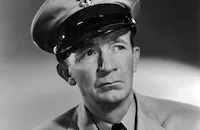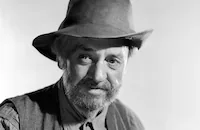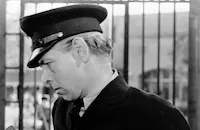They Shall Have Music

Brief Synopsis
Cast & Crew
Archie Mayo
Jascha Heifetz
Andrea Leeds
Joel Mccrea
Gene Reynolds
Walter Brennan
Film Details
Technical Specs

Synopsis
Young Frankie, a victim of a squalid life in the slums, fancies himself a tough guy until hearing a performance by violinist Jascha Heifetz. Inspired by the maestro, Frankie returns to his violin, an instrument his late father had taught him to play as a baby. After his cruel stepfather smashes the instrument and threatens to send the boy to reform school, Frankie runs away from home and stumbles upon a music school for underprivileged children run by kindly Professor Lawson and his daughter Ann. Impressed by Frankie's natural ear, the professor enrolls the boy in school and offers him refuge from the streets. Unknown to the Professor, the school's existence is threatened by Flower, one of its creditors, who insists that the school charge tuition or he will shut it down. When Frankie overhears Ann and her boyfriend, Peter McCarthy, discussing the dismal financial situation, he organizes the pupils to perform on the street. After hearing one of their concerts, Heifetz shows an interest in the school, and Peter, to put off his creditors, tells them that Heifetz will perform at the children's concert. On the eve of the performance, Flower learns that Peter has been bluffing and sends his men to repossess the instruments. As Flower's men pry the instruments from the children's hands, Peter and Frankie manage to track Heifetz down, and he arrives just in time to perform with the children and save the school.

Director

Archie Mayo
Cast
Jascha Heifetz

Andrea Leeds

Joel Mccrea

Gene Reynolds

Walter Brennan

Porter Hall

Terry Kilburn
Walter Tetley
Chuck Stubbs
Tommy Kelly
Jacqueline Nash

Alfred Newman
Mary Ruth
John St. Polis
Alexander Schonberg

Marjorie Main

Arthur Hohl

Paul Harvey
Zero
The Peter Meremblum California Junior Symphony Orchestra

Dolly Loehr

J. Farrell Macdonald

James Flavin
Crew
James Basevi
Jeanne Beakhurst
Irmgard Von Cube
Samuel Goldwyn
Julia Heron
John Howard Lawson
Walter Mayo
Felix Mendelssohn
Paul Neal
Alfred Newman
Jack Reynolds
Robert Riskin
Charles Camille Saint-saëns
Ned Scott
Peter Ilyich Tchaikovsky
Sherman Todd
Gregg Toland

Film Details
Technical Specs

Award Nominations
Best Score
Articles
They Shall Have Music
Joel McCrea, Andrea Leeds and Walter Brennan all co-star in They Shall Have Music, but it is Jascha Heifetz playing himself in his feature film debut who receives top billing. According to A. Scott Berg's 1989 book Goldwyn: A Biography, Samuel Goldwyn had long wanted to be the first person to put Jascha Heifetz, considered by many to be the greatest violinist of all time, in the movies. When he discovered that Heifetz would be spending the summer of 1938 in California, Goldwyn moved quickly. He got Heifetz to sign a contract that would give Goldwyn access to him for any four weeks during the season in exchange for $75,000. Although there was no screenplay or story at that point, Goldwyn knew that Heifetz would play himself and that one of his performances would be an important plot point in the final script.
Several different writers pitched story ideas that would feature Heifetz, but none appealed to Goldwyn. Meanwhile, the summer was quickly drawing to an end, and with it the terms of Heifetz's contract. Goldwyn was getting desperate. Finally a writer named Irmgard von Cube came up with the idea of setting the story around a music school. With that initial concept in mind, another writer, John Howard Lawson, went to work hammering out a full screenplay based on that idea.
With time running out, Goldwyn decided to go ahead and film the concert finale of They Shall Have Music with Heifetz even though the script was far from finished. That way, at least the Heifetz portion of the film would be done before his contract expired. Goldwyn asked William Wyler to direct the concert scene, which had Heifetz performing along with the students of the music school. Even though it was the only portion of the film that he shot, Wyler was proud of his work. "I shot it all on a stage at the studio," recalled Wyler in Axel Madsen's authorized 1973 biography William Wyler. "I had Heifetz and the Peter Meremblum California Junior Symphony Orchestra and filmed the playing of Saint-Saens' 'Rondo Capriccioso', 'Hora Staccato' by Dinicu-Heifetz, Tchaikovsky's 'Melodie,' and the last movement of Mendelssohn's 'Concerto.' I loved it!"
By the time a final screenplay was completed for They Shall Have Music, Heifetz's contract had expired. Additional scenes featuring Heifetz had been written, but he had already left California. Goldwyn enticed him back to Los Angeles in March 1939 by agreeing to pay him a hefty sum for completing the new scenes.
While William Wyler had originally shot the first completed scenes of They Shall Have Music, he was busy with another project when Goldwyn was finally ready to complete the film. A new director was needed. Goldwyn hired Archie Mayo for the job, though Mayo was far from his first choice. Mayo had recently fallen out of Goldwyn's favor when his film The Adventures of Marco Polo (1938) had been a colossal flop for The Samuel Goldwyn Company. Goldwyn had put the blame squarely on Mayo's shoulders and wouldn't let him forget it. He would have fired Mayo, but Goldwyn was obligated to let Mayo work since he was under a long term contract with the company. Nonetheless, Goldwyn made a point to treat Mayo so badly that he hoped it would drive him to leave the company on his own. Mayo stuck it out, however, and did the best job he could on They Shall Have Music.
For several weeks before the film was released, Goldwyn tried to publicize They Shall Have Music as much as possible. He had recently befriended New York Times publisher Arthur Sulzberger and his wife Iphigene, and the New York Times reciprocated by writing several articles about the film before its opening to help drum up interest.
They Shall Have Music premiered on July 24, 1939 at the grand Rivoli Theatre in New York City. In keeping with the message of the film, that first screening was a benefit to aid the Greenwich House Music School and the High School of Music and Art, two local institutions that provided musical education to underprivileged children. Among the distinguished guests in attendance that night were Eleanor Roosevelt and New York Mayor Fiorello LaGuardia.
Time magazine said in its review, "They Shall Have Music (United Artists-Samuel Goldwyn) is a triumphant answer to the current Hollywood theory that it is impossible to make a good picture about a great musical celebrity." The New York Times said, "...the crystal purity of Mr. Heifetz's playing, the eloquent flow of melody from his violin and the dramatic presentation of the artist commanding his instrument - close-ups of his graceful fingers upon the strings, of the majestic sweep of his bowing arm and brilliant angle-shots of the man before an orchestra - create an effect of transcendent beauty which is close to unique in this medium...Gene Reynolds, as the boy who makes good, carries the heaviest role commendably...And especial mention must be made of the Peter Meremblum California Junior Symphony Orchestra, which accompanies Mr. Heifetz in one number. It is the grandest appeal for musical education in the picture. It - and, of course, Mr. Heifetz."
The children of the Peter Meremblum California Junior Symphony Orchestra, who play the students at the music school that Frankie attends, deserve a special mention for the astounding talent they display in They Shall Have Music. The orchestra was a group of talented young musicians first assembled in 1936 under the direction of Peter Meremblum, a Russian born conductor who wanted to bring European musical training to young people in America. Jascha Heifetz himself was very impressed with the orchestra. "When Heifetz first saw and heard them on the screen," according to a 1939 New York Times article, "he refused to believe that they were doing the actual playing and had to be taken to hear them in person before he could be convinced. The studio heads had hoped to induce him to appear with them on the screen, and spent anxious hours debating the most diplomatic way of asking him to do so. When he had heard the youngsters, he asked to be allowed to play with them." Peter Meremblum passed away in 1966, but the orchestra that he started lives on to this day, now known as the Peter Meremblum Youth Orchestra.
They Shall Have Music is an engaging film, offering a rare opportunity to watch Jascha Heifetz perform at the peak of his career. "It shows Heifetz, on the platform of a concert hall, playing Saint-Saen's 'Introduction and Rondo Capriccioso'...and, in accordance with motion picture technique, shows the player not merely as one would see him from a seat in the auditorium, but from many angles and at varying distances - long shots, medium long shots, close-ups and what one might call close-close-ups, views of the bow and the wonderfully controlled arm that propels it, glimpses of the flashing fingers of that miraculous left hand," wrote Deems Taylor in a 1939 New York Times article. "I thought then, with what despairing admiration a violinist must watch those fingers. But I thought, too, how I would haunt this picture, if I were a violinist, if only for the sake of seeing, as no one has ever seen before, how Heifetz does it."
They Shall Have Music also received an Academy Award nomination for Alfred Newman's original musical score. Alfred Newman himself also makes a rare on-screen appearance as a Musical Director.
Producer: Samuel Goldwyn
Director: Archie Mayo
Screenplay: John Howard Lawson, Irmgard von Cube
Cinematography: Gregg Toland
Art Direction: James Basevi
Film Editing: Sherman Todd
Cast: Jascha Heifetz (himself), Joel McCrea (Peter McCarthy), Andrea Leeds (Ann Lawson), Gene Reynolds (Frankie), Walter Brennan (Professor Lawson), Terry Kilburn (Limey), Porter Hall (Mr. Flower), Walter Tetley (Rocks Mulligan), Chuck Stubbs (Fever Jones), Tommy Kelly (Willie).
BW-102m.
by Andrea Passafiume

They Shall Have Music
Quotes
Trivia
In the movie, the newspaper account lists Heifetz's stolen Violin as a Stradivarius. Heifetz actually used a Guarnarius in the picture and favored that violin in real life, but the movie personnel felt that the name of Stradivarius would be more recognizable.
Gene Reynolds, who plays Frankie, would go on to a successful career as a TV producer and director, most notably of "M*A*S*H" (1972).
Notes
The working titles of this film were The Restless Age, Angels Making Music and Music School. According to a pre-production news item in Hollywood Reporter, producer Samuel Goldwyn originally considered George Arliss and Walter Brennan for the role of the music master. According to modern sources, however, Goldwyn made this film because he wanted to put violin virtuoso Jascha Heifetz in the movies. Another pre-production news item in Hollywood Reporter notes that still photographer Ned Scott took over from Bob Coburn, who left to work on The Real Glory. Other news items in Hollywood Reporter add that Goldwyn was arranging a tour of twenty-two key cities for the forty-five-piece children's orchestra that appears in this film. Actress Diana Lynn, who was a child prodigy, used the name Dolly Loehr at the time that she made this film. This was the then ten-year-old actress' first film. Al Newman was nominated for an Academy Award in the Music (Scoring) category.

Miscellaneous Notes
Released in United States 1939
Released in USA on video.
Released in United States 1939













